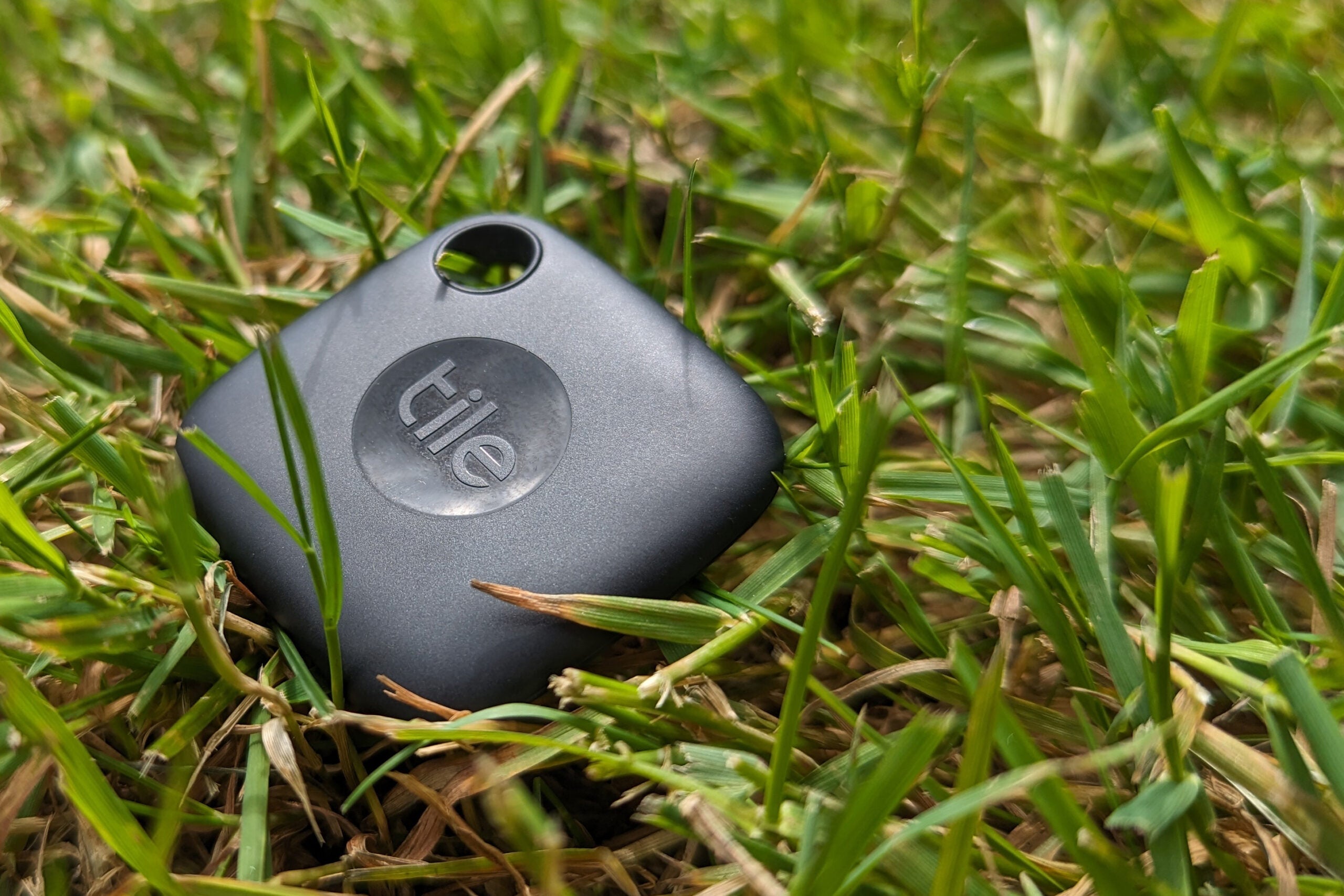Verdict
The Tile Mate (2022) is the cheapest of the Tile locators, and gives up little to the Pro or Slim. It’s perfect for slipping on your key ring, the dog’s collar, or leaving in a bag or your car, and has a good direct detection radius. It’s an effective system, though its reliance on Bluetooth and the Tile network of users means it’s still possible to lose your Tile-protected items in a deserted area.
Pros
- Nicely made
- Good Bluetooth range
- Three-year battery
Cons
- Battery can’t be replaced
- Bluetooth only
- No ultra wideband
-
Works with Android and Apple devices:Offers app compatability with both Android and iOS devices. -
76-metre range:Tile claims the Mate can connect to your phone up to 76 metres (250ft) away.
-
IP67 water resistance:Protected against dust and sand, and can survive being dunked under water for 30 minutes.
Introduction
Finding lost things becomes much easier when you’ve got a locator attached to your valuables, and Tile’s latest refresh of its Mate keyfob-sized tracker claims to have upped the Bluetooth accuracy and range (though this is still less than the Tile Pro), so you’ll be more likely to find what you’re looking for.
As Tile’s devices rely on nearby phones to detect them, which then pass the location information back to you, this increased range is welcome.
A set of keys dropped by the river is only going to be located if the Tile Mate, hooked on the keyring, is able to report its location to someone. And if you lose something in a deserted area, it’s a matter of luck whether a walker with the app on their phone wanders past. But in more populated areas, the Tile Mate has all the range you need to locate it.
Design
- Small enough to blend in
- Tactile button
- Battery not replaceable
The 2022 edition of the Tile Mate comes in at a few millimetres larger, and just over a gram heavier, than the 2020 version. Otherwise it works in exactly the same way, emitting a Bluetooth signal that can be picked up by your phone or any other that’s signed into the Tile network, allowing you to pick up its location in the app, go there, then command it to play a tune so you can zero in on it.
There’s also reverse finding, where you click the button on the Mate twice and your phone starts making a noise.
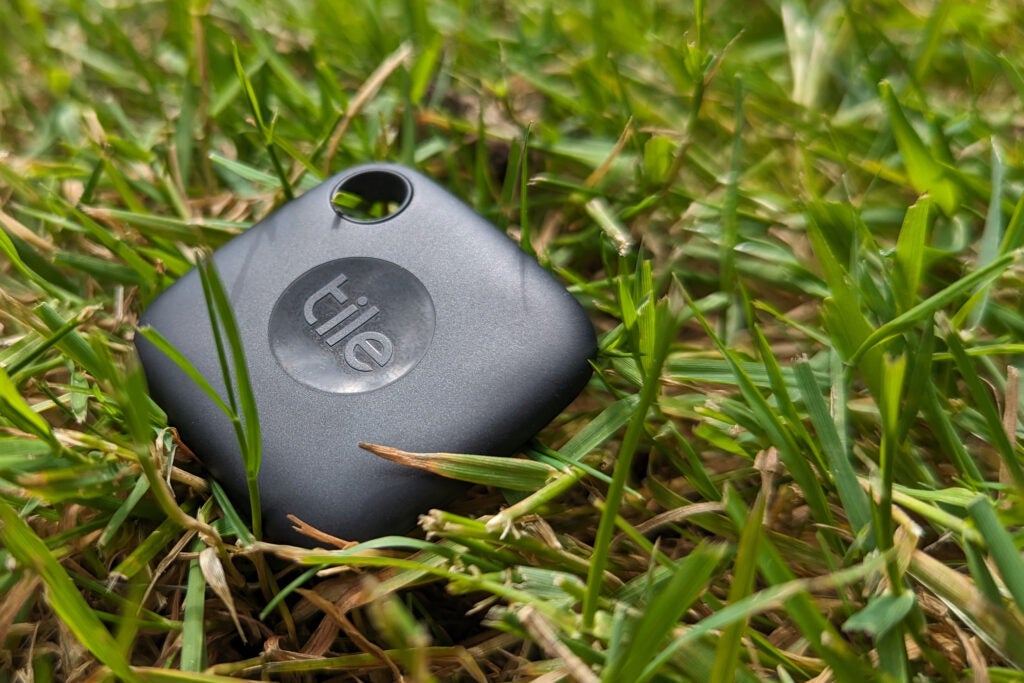
The Tile Mate (2022) is a small plastic square with rounded corners that comes in white or black – though special editions with sparkly or bright green casings are available. The surface is smooth, with a hole at one corner to attach it to the likes of your keyring. There’s a depressed button with the Tile logo on it for pairing and phone-finding, and a QR code on the back along with the small text no one reads. It’s a minimal design, but one that does everything you’d want of it.
There’s a noticeable seam around the edge, where the two halves of the plastic case have been pressed together. The Mate has an IP67 ingress protection rating, which means it’s sealed against dust and other particles, as well as being water resistant. It’s not going to survive indefinitely if left underwater, but it has enough protection to keep going for a bit before it expires.
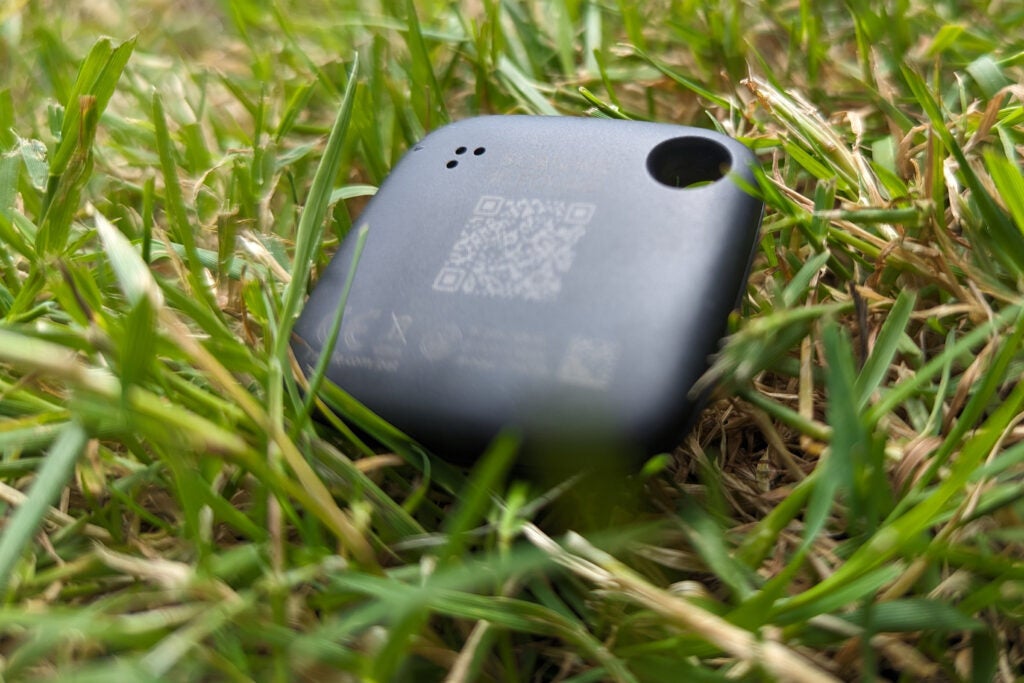
And expire it will, eventually. The battery is non-removable (unlike the 2018 and 2020 versions of the Mate) and rated to last for three years. They can be disposed of at suitable e-waste facilities, but if you require a 2022 Tile with a replaceable battery, you’re going to want the Pro model.
Performance
- Good range
- Loud speaker
- Bluetooth only
Most of the time, you won’t need to think about the Tile Mate. It will just sit where you put it, whether that’s on a key ring or in the bottom of your handbag, until it’s needed.
When it is, assuming the battery still has some juice in it, you’ll be able to open the Tile app on your phone to find out where and when it last connected to the network.
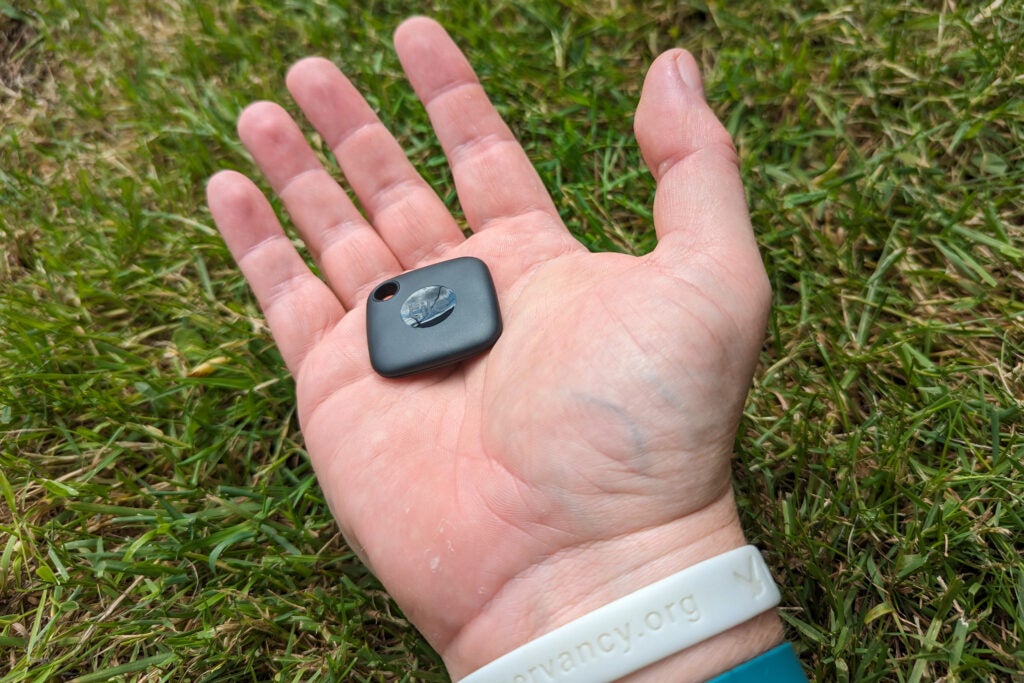
In my testing (leaving it in a car with the windows down and walking away) I found that the claims of an increased 75m (250ft) range hold true. When I was 50m away from the tracker, the app still saw a ‘moderate’ signal strength, and I could just about hear the chirpy tune played from the Mate’s speaker at this distance.
Signal and audibility fell off as I moved farther away, but it continued showing a weak signal at a surprising distance. There’s no ultra wideband support, as seen in the Apple AirTag, which means it’s reliant on the crowded 2.4GHz part of the spectrum.
It could, therefore, be prone to interference in busy areas full of other electronics banging away with their Bluetooth, which will reduce the range. However, those busy areas are also the sort of places you’d find lots of Tile users contributing to the network.
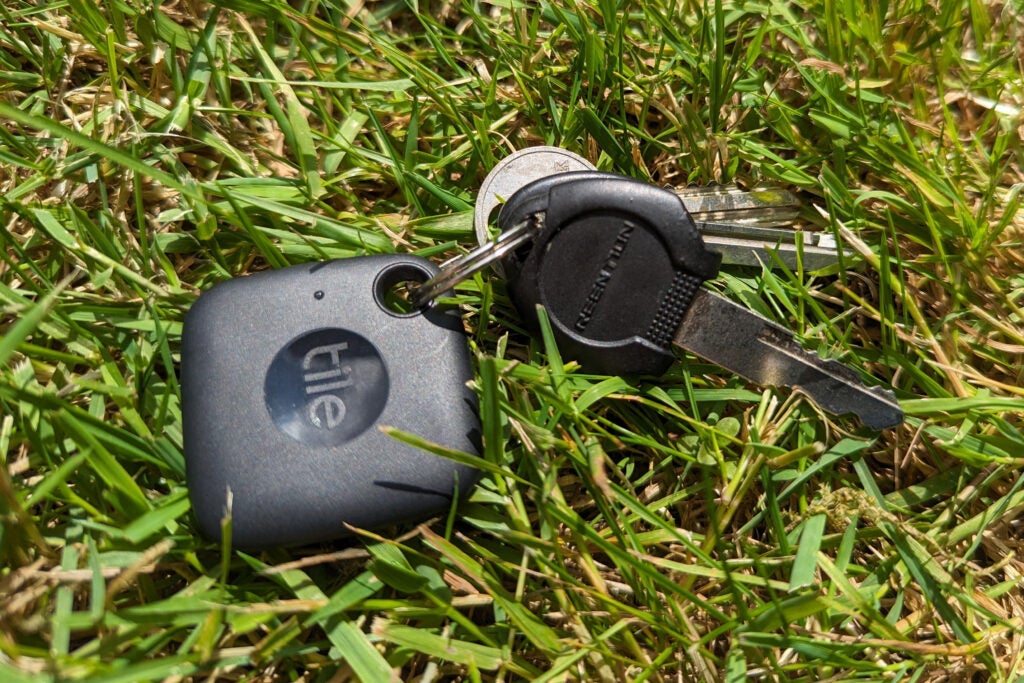
The reverse finding feature, where you double-tap the Tile logo button on the Mate and it makes your phone sing out its location with a variant of its annoying tune, works well with little delay between pressing the button and your phone beginning the incessant music that advertises its location.
The Tile chirps a bit while it’s making contact, but when your phone starts making a noise the only way to shut it up is to unlock it. If your phone’s Bluetooth is switched off, however, it’s not going to work – but this is a feature Tile can boast of that competitors like the Apple AirTag don’t have.
Software
- Map view
- Responsive
- Subscription-only features
Most of your interactions with your Tile devices will be through the app. It shows the Tiles you’ve added to your account in a grid view, and tells you how many Tile members there are inside a circle (about five miles in radius) around your location. The more members, the more chance there is to find your device if it goes missing.
Adding a device is as simple as selecting the option in the app, clicking the device’s button, then leaving the Tile and phone near each other while they get to know one another. You can give each device a nickname, making it easier to remember which is which.
A new feature for the 2022 Tiles is the QR code that’s printed on the back with a simple instruction to scan it. If someone finds your missing Tile, they can scan the code and register that they’ve found it, the location then appearing in your app via a notification. This matches the functionality of Tile’s Lost and Found stickers.
Take out a Tile Premium subscription, and you get smart alerts – if you try to exit the house and leave your Tile-attached keys behind, you’ll get a phone notification to remind you. There’s also a 30-day location history for all your Tile devices, so you can see where they’ve been, an extra warranty, and the ability to share your Tile so others can see where your devices are.
There’s nothing there that stops a Tile device working perfectly well without the Premium subscription, but it’s a nice extra to have, and I appreciate Tile not locking an essential function behind the paywall.
Latest deals
Should you buy it?
You want a simple, affordable tracker:
The Tile Mate is a superb option if you want something discreet, cheap, and capable for locating an item if it’s lost.
You want to use it for more than three years:
If you want a tracker with a replaceable battery, then the Pro model is a better shout.
Final Thoughts
The Tile Mate (2022) could be an essential purchase if you’re someone that often loses their keys, or just wants to know where their cat is at any given moment.
Its Bluetooth range is reasonable, the noise it makes can be heard from a distance of about 50m, and The Tile network is reliable for finding your devices as long as there are people around. It may lack the ultra wideband support of Apple’s AirTags, but as the cheapest member of the Tile family, the Mate makes a lot of sense.
How we test
We make sure to spend at least a week with each tracker, testing all of the advertised features. We’ll also test the range of the product, and how easy it is to set up.
We spend at least a week testing each tracker.
We test the maximum range of each tracker.
FAQs
Tile offers an optional Premium plan that requires a monthly fee. This provides access to extra features such as smart alerts, 30-day location history and worry-free warranty. It costs $2.99/£2.99 per month.
If you’re happy to stick to the basic functionality of the Tile Mate, there’s no need to pay this monthly fee.
Yes, once synced up, you can press a button on the Tile Mate to cause your connected phone to make a noise.
Verdict
The Tile Mate (2022) is the cheapest of the Tile locators, and gives up little to the Pro or Slim. It’s perfect for slipping on your key ring, the dog’s collar, or leaving in a bag or your car, and has a good direct detection radius. It’s an effective system, though its reliance on Bluetooth and the Tile network of users means it’s still possible to lose your Tile-protected items in a deserted area.
Pros
- Nicely made
- Good Bluetooth range
- Three-year battery
Cons
- Battery can’t be replaced
- Bluetooth only
- No ultra wideband
-
Works with Android and Apple devices:Offers app compatability with both Android and iOS devices. -
76-metre range:Tile claims the Mate can connect to your phone up to 76 metres (250ft) away.
-
IP67 water resistance:Protected against dust and sand, and can survive being dunked under water for 30 minutes.
Introduction
Finding lost things becomes much easier when you’ve got a locator attached to your valuables, and Tile’s latest refresh of its Mate keyfob-sized tracker claims to have upped the Bluetooth accuracy and range (though this is still less than the Tile Pro), so you’ll be more likely to find what you’re looking for.
As Tile’s devices rely on nearby phones to detect them, which then pass the location information back to you, this increased range is welcome.
A set of keys dropped by the river is only going to be located if the Tile Mate, hooked on the keyring, is able to report its location to someone. And if you lose something in a deserted area, it’s a matter of luck whether a walker with the app on their phone wanders past. But in more populated areas, the Tile Mate has all the range you need to locate it.
Design
- Small enough to blend in
- Tactile button
- Battery not replaceable
The 2022 edition of the Tile Mate comes in at a few millimetres larger, and just over a gram heavier, than the 2020 version. Otherwise it works in exactly the same way, emitting a Bluetooth signal that can be picked up by your phone or any other that’s signed into the Tile network, allowing you to pick up its location in the app, go there, then command it to play a tune so you can zero in on it.
There’s also reverse finding, where you click the button on the Mate twice and your phone starts making a noise.

The Tile Mate (2022) is a small plastic square with rounded corners that comes in white or black – though special editions with sparkly or bright green casings are available. The surface is smooth, with a hole at one corner to attach it to the likes of your keyring. There’s a depressed button with the Tile logo on it for pairing and phone-finding, and a QR code on the back along with the small text no one reads. It’s a minimal design, but one that does everything you’d want of it.
There’s a noticeable seam around the edge, where the two halves of the plastic case have been pressed together. The Mate has an IP67 ingress protection rating, which means it’s sealed against dust and other particles, as well as being water resistant. It’s not going to survive indefinitely if left underwater, but it has enough protection to keep going for a bit before it expires.

And expire it will, eventually. The battery is non-removable (unlike the 2018 and 2020 versions of the Mate) and rated to last for three years. They can be disposed of at suitable e-waste facilities, but if you require a 2022 Tile with a replaceable battery, you’re going to want the Pro model.
Performance
- Good range
- Loud speaker
- Bluetooth only
Most of the time, you won’t need to think about the Tile Mate. It will just sit where you put it, whether that’s on a key ring or in the bottom of your handbag, until it’s needed.
When it is, assuming the battery still has some juice in it, you’ll be able to open the Tile app on your phone to find out where and when it last connected to the network.

In my testing (leaving it in a car with the windows down and walking away) I found that the claims of an increased 75m (250ft) range hold true. When I was 50m away from the tracker, the app still saw a ‘moderate’ signal strength, and I could just about hear the chirpy tune played from the Mate’s speaker at this distance.
Signal and audibility fell off as I moved farther away, but it continued showing a weak signal at a surprising distance. There’s no ultra wideband support, as seen in the Apple AirTag, which means it’s reliant on the crowded 2.4GHz part of the spectrum.
It could, therefore, be prone to interference in busy areas full of other electronics banging away with their Bluetooth, which will reduce the range. However, those busy areas are also the sort of places you’d find lots of Tile users contributing to the network.

The reverse finding feature, where you double-tap the Tile logo button on the Mate and it makes your phone sing out its location with a variant of its annoying tune, works well with little delay between pressing the button and your phone beginning the incessant music that advertises its location.
The Tile chirps a bit while it’s making contact, but when your phone starts making a noise the only way to shut it up is to unlock it. If your phone’s Bluetooth is switched off, however, it’s not going to work – but this is a feature Tile can boast of that competitors like the Apple AirTag don’t have.
Software
- Map view
- Responsive
- Subscription-only features
Most of your interactions with your Tile devices will be through the app. It shows the Tiles you’ve added to your account in a grid view, and tells you how many Tile members there are inside a circle (about five miles in radius) around your location. The more members, the more chance there is to find your device if it goes missing.
Adding a device is as simple as selecting the option in the app, clicking the device’s button, then leaving the Tile and phone near each other while they get to know one another. You can give each device a nickname, making it easier to remember which is which.
A new feature for the 2022 Tiles is the QR code that’s printed on the back with a simple instruction to scan it. If someone finds your missing Tile, they can scan the code and register that they’ve found it, the location then appearing in your app via a notification. This matches the functionality of Tile’s Lost and Found stickers.
Take out a Tile Premium subscription, and you get smart alerts – if you try to exit the house and leave your Tile-attached keys behind, you’ll get a phone notification to remind you. There’s also a 30-day location history for all your Tile devices, so you can see where they’ve been, an extra warranty, and the ability to share your Tile so others can see where your devices are.
There’s nothing there that stops a Tile device working perfectly well without the Premium subscription, but it’s a nice extra to have, and I appreciate Tile not locking an essential function behind the paywall.
Latest deals
Should you buy it?
You want a simple, affordable tracker:
The Tile Mate is a superb option if you want something discreet, cheap, and capable for locating an item if it’s lost.
You want to use it for more than three years:
If you want a tracker with a replaceable battery, then the Pro model is a better shout.
Final Thoughts
The Tile Mate (2022) could be an essential purchase if you’re someone that often loses their keys, or just wants to know where their cat is at any given moment.
Its Bluetooth range is reasonable, the noise it makes can be heard from a distance of about 50m, and The Tile network is reliable for finding your devices as long as there are people around. It may lack the ultra wideband support of Apple’s AirTags, but as the cheapest member of the Tile family, the Mate makes a lot of sense.
How we test
We make sure to spend at least a week with each tracker, testing all of the advertised features. We’ll also test the range of the product, and how easy it is to set up.
We spend at least a week testing each tracker.
We test the maximum range of each tracker.
FAQs
Tile offers an optional Premium plan that requires a monthly fee. This provides access to extra features such as smart alerts, 30-day location history and worry-free warranty. It costs $2.99/£2.99 per month.
If you’re happy to stick to the basic functionality of the Tile Mate, there’s no need to pay this monthly fee.
Yes, once synced up, you can press a button on the Tile Mate to cause your connected phone to make a noise.



















